Skin Material | VRaySkinMtl
This page provides information on the V-Ray Skin Material.
Page Contents
Overview
VRaySkinMtl is a material specifically designed for rendering skin. In comparison to the Subsurface Scattering Material | VRayFastSSS2 material, which can also be used for the same purpose, the goal of the VRaySkinMtl material is to provide artists with greater control and to simplify the setup of the material.
The material is composed of several different layers which are added together: a diffuse layer, three sub-surface scattering layers, and two reflection layers. The contribution of each layer relative to the other layers is controlled by an "amount" value. Additionally, the sub-surface layers are grouped so that their total contribution can be clamped. The same is implemented for the two reflection layers.
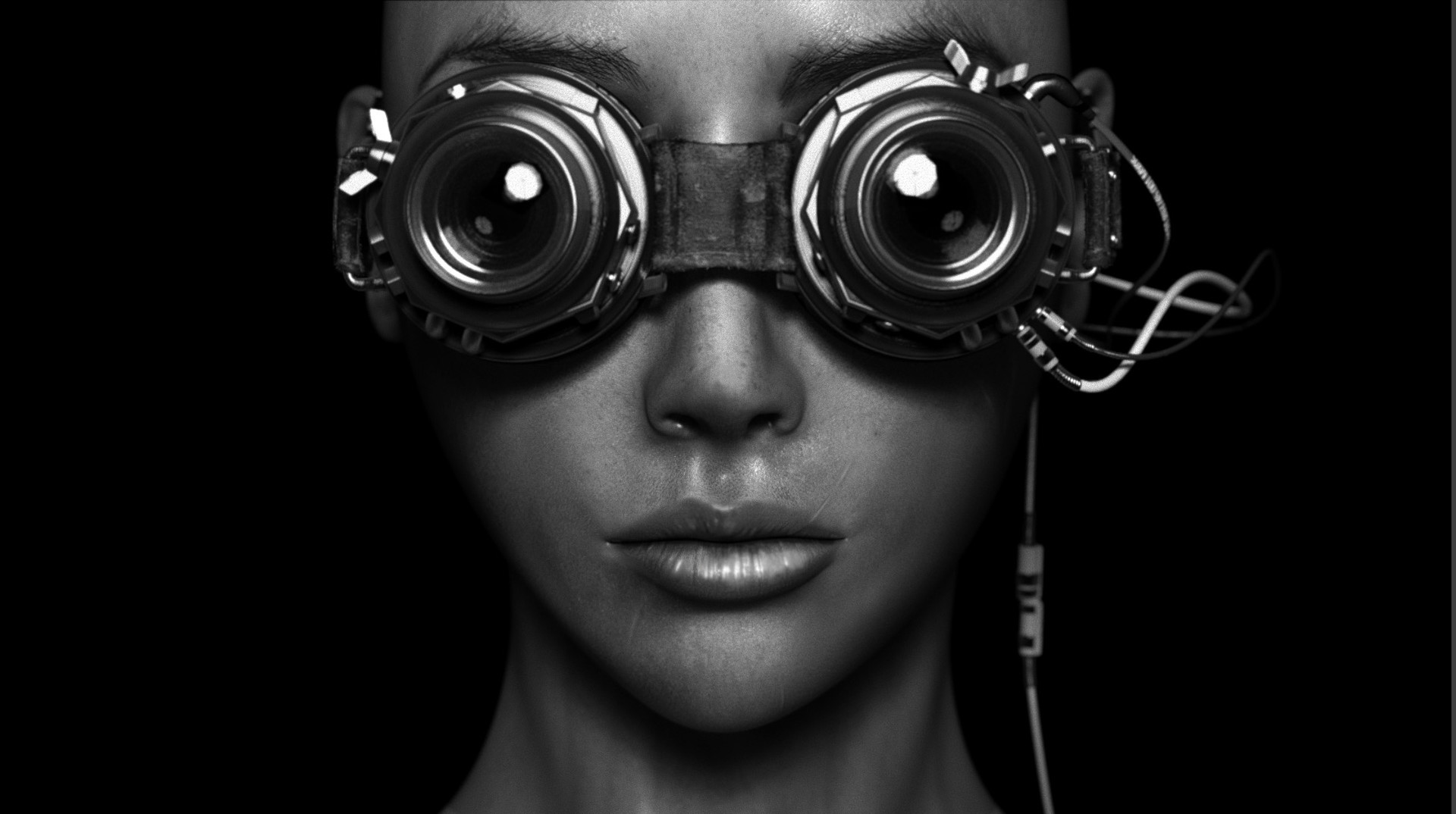
©
Frederik Rieckher
UI Path: ||Material Editor window|| > Material/Map Browser > Materials > V-Ray > VRaySkinMtl
General Parameters
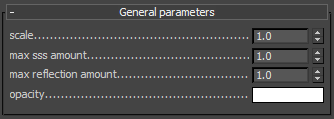
scale – Allows the user to quickly scale the sub-surface scattering effect up or down. This is a multiplier for the individual shallow, medium, and deep radius values.
max sss amount – Limits the total contribution of the sub-surface scattering layers to the specified value. If the sum of the individual shallow, medium, and deep scattering layers exceeds the Max sss amount value, the amounts are renormalized so that their sum is the same as the Max sss amount.
max reflection amount – Limits the total contribution of the reflection layers to the specified value. If the sum of the Primary reflection amount and the Secondary reflection amount exceeds this value, the amounts are renormalized so that their sum is the same as Max reflection amount.
opacity – controls the transparency of the material. Higher values are more opaque, and darker values are more transparent.
Diffuse Rollout

diffuse color – Specifies the color for the diffuse layer.
diffuse amount – Specifies the relative contribution of the diffuse layer to the material.
Shallow Scattering Rollout

shallow color – Specifies the color for the shallow scattering layer.
shallow amount – Specifies the relative contribution of the shallow scattering layer to the material.
shallow radius – Specifies the distance that light is scattered within the shallow layer in cm.
Medium Scattering Rollout

medium color – Specifies the color for the medium scattering layer.
medium amount – Specifies the relative contribution of the medium scattering layer to the material.
medium radius – Specifies the distance that light is scattered within the medium layer in cm.
Deep Scattering Rollout

deep color – Specifies the color for the deep scattering layer.
deep amount – Specifies the relative contribution of the deep scattering layer to the material.
deep radius – Specifies the distance that light is scattered within the deep layer in cm.
Primary Reflection Rollout
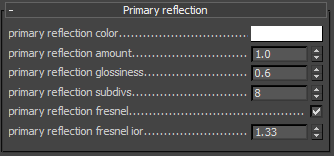
primary reflection color – Specifies the color for the primary reflections.
primary reflection amount – Specifies the relative contribution of the primary reflection layer to the material.
primary reflection glossiness – Specifies the glossiness value for the primary reflection.
primary reflection subdivs – Determines the number of samples used for computing glossy reflections from the primary reflection layer. Note that this parameter is available for changing only when Use local subvis is enabled in the Global DMC Settings.
primary reflection fresnel – When enabled, a Fresnel term will be applied to the strength of the reflection.
primary reflection fresnel IOR – Specifies the IOR value used to compute reflection strength if Primary reflection fresnel is enabled.
Secondary Reflection Rollout
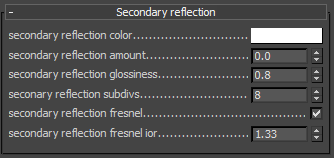
secondary reflection color – Specifies the color for the secondary reflections.
secondary reflection amount – Specifies the relative contribution of the secondary reflection layer to the material.
secondary reflection glossiness – Specifies the glossiness value for the secondary reflection.
secondary reflection subdivs – Determines the number of samples used for computing glossy reflections from the secondary reflection layer. Note that this parameter is available for changing only when Use local subvis is enabled in the Global DMC Settings.
secondary reflection fresnel – When enabled, a Fresnel term will be applied to the strength of the reflection.
secondary reflection fresnel IOR – Specifies the IOR value used to compute reflection strength if Secondary reflection fresnel is enabled.
Multiple Scattering Options Rollout
There are several different algorithms for calculating multiple scattering in the sub-surface layers. This section allows the user to select an algorithm and adjust its parameters.
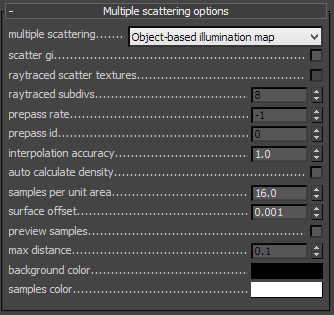
multiple scattering – Selects the type of algorithm.
Prepass-based illumination map – Approximates sub-surface scattering by precomputing an illumination map on the surface of the object; this map is built using V-Ray's prepass system (the same one used for the irradiance map and interpolated glossy reflections/refractions). The advantage of this method is that it is quite fast, since the illumination map is only computed for the portions of objects that are visible to the camera. Also, the amount of calculations is proportional to the screen space taken up by the object. A disadvantage is that no information is generated for parts of objects outside the screen, which may lead to incorrect results for objects which are only partially visible. Since the distribution of the samples depends on the camera position, flickering is possible in animation. Finally, objects that are far away from the camera may be sampled insufficiently, leading to incorrect results.
Object-based illumination map – Approximates sub-surface scattering by precomputing illumination on the object's surface; however the points are distributed directly on the surface on the object with a specified density. This method avoids the problems of flickering and insufficient sampling for far-away objects, however it may calculate a lot more illumination points that are needed strictly to render the image.
Raytraced – Uses raytracing to distribute points on the object's surface. It does not require precomputation and is suitable for use with the Progressive image sampler. The only disadvantage of this method is that it can introduce noise in the image if the raytraced samples are insufficient.
scatter gi – When enabled, GI is taken into account when calculating multiple scattering. Otherwise, GI is approximated as if the surface is diffuse. Enabling this option leads to more accurate results when using GI, but may slow down the rendering.
raytraced scatter textures – Controls whether the textures for the sub-surface scattering layers are taken into account when computing the scattering. Enabling this option may lead to more accurate results, but adds quite a bit of render time. For more information, see Raytraced Scatter Textures example below.
raytraced subdivs – Determines the number of samples used to compute multiple sub-surface scattering when the type is set to Raytraced. Larger values decrease the noise, but take longer to compute.
prepass rate – Determines the resolution of the prepass used to compute the helper illumination map when the type is set to Prepass-based illumination map. Larger values produce more accurate results, but take longer to compute. For example, a value of -1 means that the prepass will be done at half the image resolution, 0 means that the prepass will be done with the full image resolution etc., and 1 means twice the image resolution etc.
prepass ID – Different VRaySkinMtl materials with the same value of the Prepass ID parameter share the same illumination map. This is useful if different materials are applied to parts of the same object, but a smooth transition between them is required. A value of 0 means that the particular VRaySkinMtl material uses its own illumination map.
interpolation accuracy – Controls the quality of the approximation of the multiple scattering effect when the type is Prepass-based illumination map or Object-based illumination map. Larger values produce more accurate results, but are slower to render. Lower values render faster, but too low values may produce blocky artifacts on the surface.
auto-calculate density – Used with the Object-based illumination map. It tells the material to attempt to automatically determine the required density of the illumination samples. Note: currently this option does not work very reliably.
samples per unit area – When multiple scattering is computed with an Object-based illumination map, this parameter determines the number of illumination samples per unit area of the object. Larger values produce more samples and more dense sampling that captures surface illumination details better, but may slow down the rendering and take more RAM. Lower values render faster, but too low values may not capture the surface illumination accurately leading to artifacts. The Preview samples option can be used to visualize the position of the samples.
surface offset – Used with Object-based illumination map; this parameter specifies a small distance above the surface of the object where the illumination is actually computed, in order to avoid "surface acne" artifacts.
preview samples – This option can be used to visualize the samples in the Object-based illumination map.
max distance – Used with the Preview samples option and specifies how large the visualized samples will be.
background color – Used with the Preview samples option to specify the background against which the samples are visualized.
samples color – Used with the Preview samples option to specify the color of the individual samples.
Example: Raytraced Scatter Textures
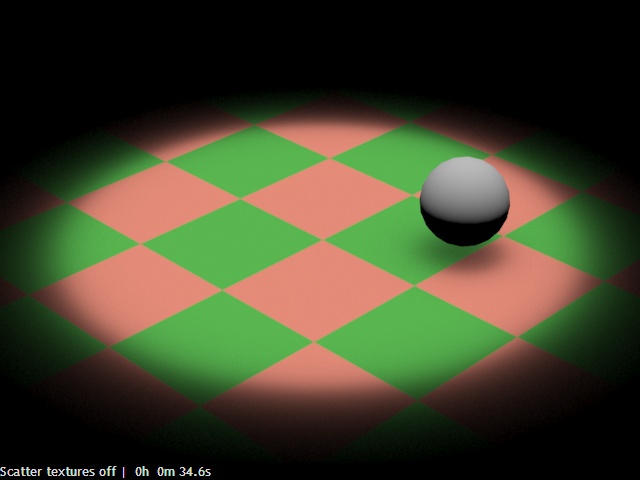 Raytraced scatter textures is disabled, only the lighting on the surface is scattered.
Raytraced scatter textures is disabled, only the lighting on the surface is scattered.
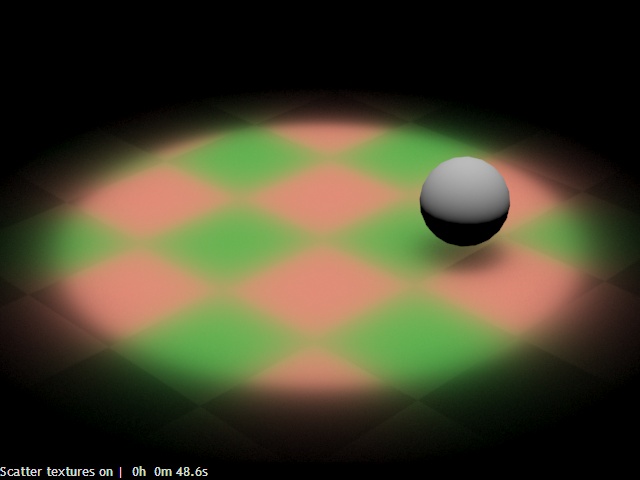 Raytraced scatter textures is enabled. The textures are also included when computing the scattering, but the render time is increased.
Raytraced scatter textures is enabled. The textures are also included when computing the scattering, but the render time is increased.
Options Rollout

trace reflections – Enables tracing of reflections from the primary and secondary reflection layers. When disabled, only highlights are computed. This can be used to speed up the shader calculations when reflections do not contribute significantly to the shader's appearance.
reflection max depth – Specifies the maximum reflection depth for the primary and secondary reflection layers.
reflection cutoff – Allows the user to skip the calculation of very dim reflections the contribution of which is below the cutoff value.